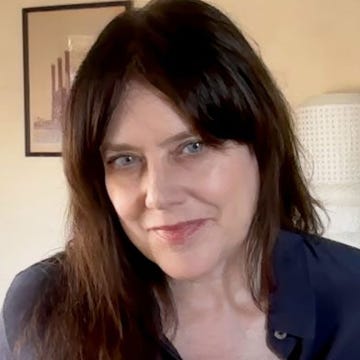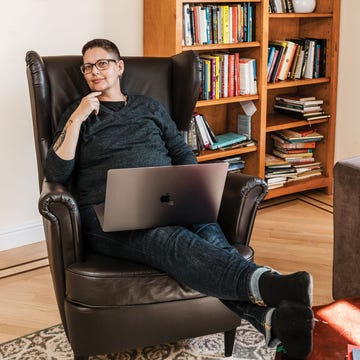You cannot impose order on Jonathan Lethem’s body of work. His nearly 30 books, spectacularly various, resist rules, and his passionate, shape-shifting engagement with culture drives his work as much as the desire to tell stories does. Perhaps Lethem’s most intellectually revealing work is The Ecstasy of Influence: Nonfictions, Etc., a defense of artistic appropriation, an opposition to the overbearing copyright regime. It approaches literary paternity from a different angle than critic Harold Bloom’s theory of the anxiety of influence, which foregrounds writers’ quasi-oedipal struggles to overcome their authorial ancestors. Across Lethem’s books, however, his cherished father, the 91-year-old painter Richard Brown Lethem, repeatedly appears, and his latest, Cellophane Bricks: A Life in Visual Culture, an intimate collection of his art writing, brimming with luminous, strange fugues, divided into six sections, is no exception.
Lethem speaks to me from a room in a coastal farmhouse in Maine, once sipping from a sky blue coffee cup. The walls are arrayed with books and artworks. During the school year, Lethem teaches at Pomona College. He begins The Disappointment Artist: Essays, “I learned to think by watching my father paint.” After starting down his father’s vocational path, Lethem dropped out of art school; early on in his writing career, he looked skeptically at claims that he was a painterly novelist. Yet, in his latest book, you can observe Lethem’s mind still vibrating along frequencies of childhood, including the early art of his father. To accompany his dissertation, Richard Brown Lethem had painted a canvas in surrealist Giorgio de Chirico’s style, replacing de Chirico’s objects with midwestern iconography. Intriguingly, like de Chirico, during Lethem’s childhood, he experienced Alice in Wonderland syndrome, a neurological disorder in which objects are perceived to be smaller or larger than they are.
What’s on display in Cellophane Bricks, which teems with striking color reproductions, are unusual considerations of personally meaningful artworks. In his youth, Lethem never took to art criticism, though he avidly read rock and film criticism. His art writing here assumes radically different forms, including translation of the visual into narratives. Explaining the origins of certain pieces, he tells me, “Every time I was asked to write about art, I would say to the person who asked, I will write you some fiction instead. So the book is much more closely related to my short stories.... It’s all done in this weird kind of ‘climb into the skin of the artist and use their style or respond to their stylistics.’”
These intense reveries sometimes lift off with the fabulism of Italo Calvino and other times race into the appealingly pop-bizarre. A surrealist methodology he sometimes uses, Lethem says, is writing down dreams upon waking. His brief fiction “Traveler Home” arose from a dream and responds to Walter Martin and Paloma Muñoz’s Traveler CLXIII at Night, a color photograph of figures in a miniature, snowy environment. Another piece, “The Collector,” a hallucinatory riff on a painting by Fred Tomaselli, describes a collector of pennies and seashells (a numismatist, like Lethem’s uncle) whose gathered objects assume mysterious resonances.
Certain autobiographical writings—anecdotes, correspondences, reflections, reminiscences, poems—grounded in empirical reality touch on books as art objects. A brief remembrance about receiving a letter from artist-of-the-fantastic Sylvie Selig. An essay on Disney hyperartifacts. In “Objectified Books,” a memory of artist Alexander Munn, who designed the jacket of Amnesia Moon, slips into a discussion about the covers of Lethem’s first three novels, which had trompe l’oeil faces.
Lethem regards both books and art as “machines for producing experience.” His passage from painter to writer, he confesses, was incomplete. “You’ve made this crossing, which in some ways is a marvelous one, because you move from the dilemma of the artist who has to have a rich person buy their single object and then put it in some horrible, ugly, secret house that you know they bought to match their couch and you don’t approve of where their money came from—to making a thing that anyone with $20 can own.” Mass production might seem like a positive, he notes, but it also leads to the aura of the book’s substance becoming “weird, implicit, and hidden.” With books, the writer concludes, “You no longer have the ur-object.”
He tells a lively anecdote about a book of his, reconstituted as an art object through political action. He’d donated an inscribed copy of Chronic City to the open-air Occupy Wall Street library. When the police destroyed the encampment, they seized everything, including the books. Later, the arrested copy that had been in custody was released, freed and returned to him—transformed.
Even before Lethem left art school, he had started putting words on canvas, dissatisfied by image alone. He began what he now considers a “novel zero, the one you don’t publish,” which emulated Philip K. Dick. Lethem leans forward. “I wanted to work with time, the way that narrative has time in it, and I wanted to work with characters and with language.” Unable to relate to what was happening in New York, needing a more “eccentric kind of participation,” he fled to the Bay Area in the 1980s. It was too late to meet Dick. He followed a familiar “model of freedom and self”—that of the Beats running away from New York. “I was a Bay Area writer before I was a Brooklyn writer.”
He says, “It’s an odd doubleness that I’ve created for myself. I really belong to both places, the West Coast and New York City. But also, it ended up corresponding to the two careers that I’ve made as a writer. One is sort of the outsider artist’s genre guy who’s very Californian.” His California novels pull strongly from science fiction and crime novels.
When framed as a California writer, Lethem further muses, he is seen as a “termite guy.” In Cellophane Bricks, he writes a piece called “Termite Footprints: On Manny Farber’s Art Writing.” It builds from an essay by Farber, a painter and film critic, titled “White Elephant Art vs. Termite Art,” which argues for what the critic calls termite art, a “buglike immersion in a small area without point or aim...the feeling that all is expendable, that it can be chopped up and flung down in a different arrangement without ruin,” over white elephant masterpieces. Farber theorizes, “A peculiar fact about termite tapeworm-fungus-moss art is that it goes always forward eating its own boundaries.”
The first boundaries Lethem tried to push through were supposedly fixed literary genres. But what he does with the writings gathered in Cellophane Bricks is a different sort of slipping across boundaries. He explains, “I’m attempting a mind meld with the artist and their process, or what I imagine is their process. By definition, I’m trapped inside my own head. So these are also confessional pieces about my working method. I use myself as a lens onto the art-making process of others—a very weird process! I’m trying to literally chew down the boundary between myself and this person.”
The enterprise of “genre” is to support the capitalist project of marketing, I suggest. What does Lethem think about the eating of boundaries as a political act? He says, “It is innately political because the genres, along with other things that they do to organize reality—everyone likes categories; it helps them think, right?—mimic hierarchies and caste systems and class structures, which of course, in our society, famously, we like to pretend don’t exist.”
Lethem’s first genre violation with science fiction was seen as a “sub-literary activity,” and for it, he encountered apprehensive resistance. “Sometimes it even resembled a distaste.... Why are you making me think about that yucky stuff that embarrasses me, like spaceships?” It’s a privilege of living a long time, he continues, to see the culture embrace science fiction.
I remind Lethem that he is respectable now. “I blundered into it. And I keep trying to get back out,” he says, immediately. “I think it would be a great thing for me to end up as peculiar as I started out in everyone’s regard. And it’ll be like, Did you know that he was really respectable in the middle of these two points? That’ll be a fascinating puzzle.”
Growing up a leftist in a leftist family that exalted art-making, Lethem sensed tension between egalitarian principles and high-art notions of the primacy of the creator. He believes that his work comes from a “social matrix of influence and other voices” and that he’s always written in “resistance to the myth of the solitary Promethean heroic image of the artist.” His work favors conversation with other books and people—making “texts” with others.
“It’s politically important to be other people,” he says. When he located the books that meant so much, it wasn’t because they underscored who he already was or what he already knew. “I was looking to be thrown out of myself into these other realities, experiences, selves, voices. So if that’s what I was seeking, then it’s going to be natural that I’m going to also try to transmit it and participate in it as the artist, right?” What he describes seems like an ecstasy gone further than that of the mystics: being brought to a rapture that makes you want to storify the sources, render them in the fourth dimension of time.
“You’re speaking to me at a time of feeling very, very fortunate as a writer,” Lethem reflects. While writing Brooklyn Crime Novel, which, to my mind, is one of the best novels of the past decade, he felt able to invite more of “the disturbance, the disobedience,” and the feedback of what he’d learned from his more disreputable activities and art writings than he had in other novels. “At this point,” he says, “I’m feeling the absolute freedom to do what I like.”•
Join us on July 25 at 5 p.m. Pacific time, when Venita Blackburn will sit down with CBC host John Freeman and a special guest to discuss Dead in Long Beach, California. Register for the Zoom conversation here.













